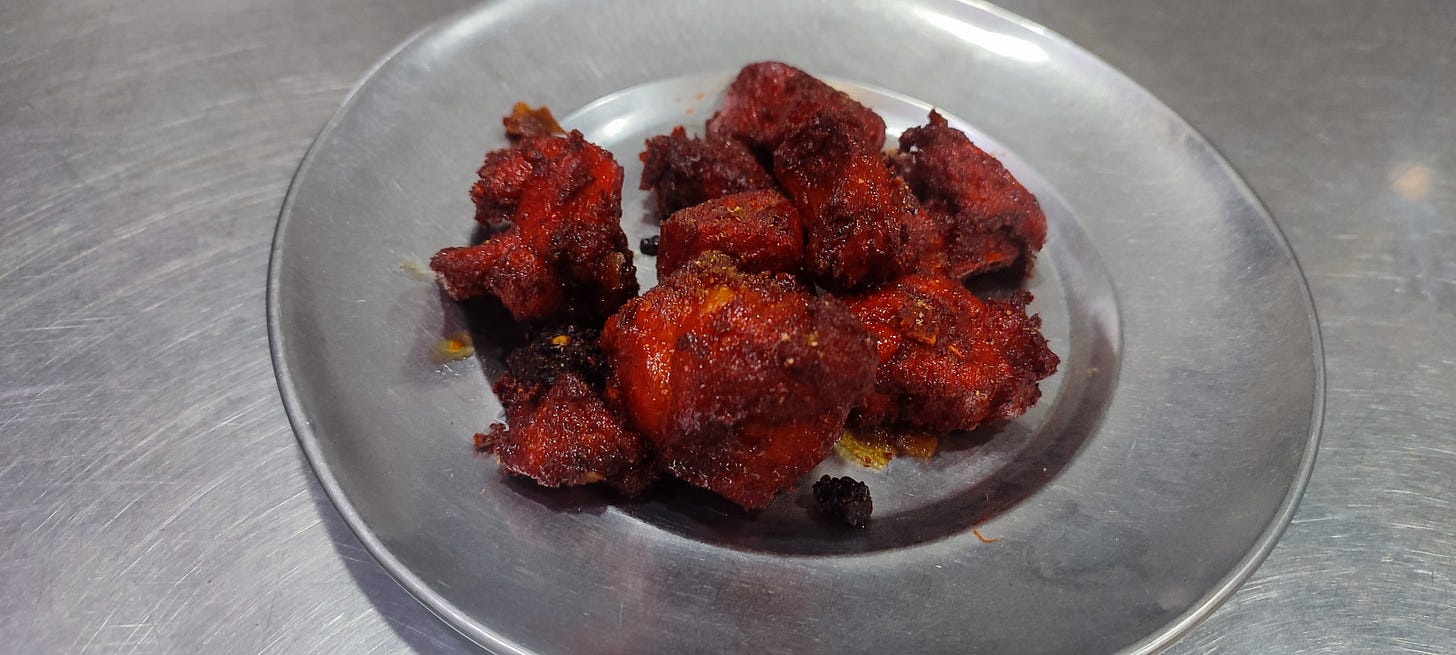G. Bera Samosa House in Ahmedabad: An Oasis of Meat in a Vegetarian City
Gujarati cuisine is viewed at from a very reductive lens. Conversations about the state’s food seldom go beyond Dhokla, Fafda, Undhiyu or a Gujarati Thali. Not only are more rural delicacies such as Umbadiyu omitted from these discussions (something that can perhaps be forgiven given such dishes are prevalent in isolated pockets, which don’t have the same connectivity to the greater world as a city like Ahmedabad does), but non-vegetarian Gujarati food is neither much talked about, nor well-documented, which is a shame. Gujarati non-vegetarian food suffers from a similar fate to more unknown regional delicacies – there simply is no one to talk about it. Most Gujarati representation in mainstream media, as well as most Gujaratis who have settled outside the state, is of the upper-caste Hindu or Jain, who don’t consume meat for purity reasons,. There is a strong taboo against meat amongst all layers of Gujarati society, one that is not merely a personal preference, but is on the verge of intolerance.
Most parts of urban Gujarati cities remain predominantly vegetarian, owing to a strong level of religious segregation, with most Muslims being forced to live in ghettos or localities of their own. There simply is not much demand for non-vegetarian food in most areas of the city (something that is changing with the years as more migrants from other states start to settle here), and in places where there potentially is, vendors may be hesitant to introduce meat dishes to an already vegetarian clientele, who insist on meat not being cooked under the same roof for purity reasons. Hence, non-vegetarian food in Gujarat remains secluded to smaller pockets – posh streets, such as Ahmedabad’s Sindhubhavan Road, whose fancy cafes are frequently visited by the richer section of society, many of whom are recent migrants to the city not prejudiced against meat, and Muslim ghettos, remain some of the few areas where meat is truly prevalent. These pockets are hidden away from the world, to whom, Gujarati food is all about misrepresented imageries of sweet daal and Fanta Maggi. Millions of innocent creatures who are unbeknownst to the wonderful variety of flavours that Gujarat’s non-vegetarian food truly is.
One of these pockets lies deep within the Old City of Ahmedabad, which has traditionally had a diverse, yet segregated population of both Muslims and Hindus. Bhathiyar Gali near Teen Darwaza is one of the older food hubs, apocryphally operated by the descendants of the royal cooks of the Gujarat Sultanate, who ruled over the city for a period of 300 years from its founding in 1411 to its fall at the hands of the Marathas in 1758. Most shops in the area barely trace their history beyond the early 1990s, so I highly doubt the authenticity of that claim.
On this street, lies G. Bera Samosa House, founded in 1998, popular for its mutton samosas and other bite-sized goodies. I am not exaggerating when I say that this is one of the most underrated meat shops in India at the moment. The tiny samosas, sold by the kilo, are packed with juicy minced mutton, flavoured with spring onion and other vegetables, which add to the dish and enhance the taste of the meat, but are not overpowering in the slightest. There is very little masala added to the samosa – though you are free to add some on top – and the overall taste remains subtle. What makes this dish special is the proportion of textures – the crispy, thin outer layer almost resembles a spring roll, except one that is full of juicy, soft, tender meat instead of noodles.
The Chicken Dana is criminally deceptive for such a simple dish. Bite-sized chunks of fried chicken – they have a strong, bright reddish colour yet are only very lightly seasoned – the seasoning itself is quite spicy but owing to it being sprinkled in moderate amounts, you only get a small kick of the masala – allowing the flavour of the succulent bits of chicken to shine.
They also serve bite-sized fried mutton meatballs called “Kebabs”, which use the same filling as the samosa. It got me thinking over why the dish was called “Kebab” – this is nowhere close to being a variety of kebab, which is usually roasted, and even the fried varieties of kebab such as Galawati Kebabs are more complex than simple meatballs. It’s perhaps just because “kebab” is a popular term that people would be aware of, or perhaps because it’s easier to pronounce than “keema goli” (minced balls), which is what it is. In any case, this small samosa shop in the heart of Ahmedabad has produced some of the best meat fare that I’ve had in my life. If I weren’t living in a dry state, I would’ve said that its the perfect chakna for you to pack for a house party, though some of my more resourceful followers may still be able to make use of that advice. Regardless of your liver health, do check this place out.
Recommendations : Chicken Dana (9.75/10), Mutton Samosa (9.75/10)
Location : New Bera Bakery opp. Karanj Police Station, Bhadra, Ahmedabad, Gujarat 380001
Thanks to Shivangi for proofreading this piece.




